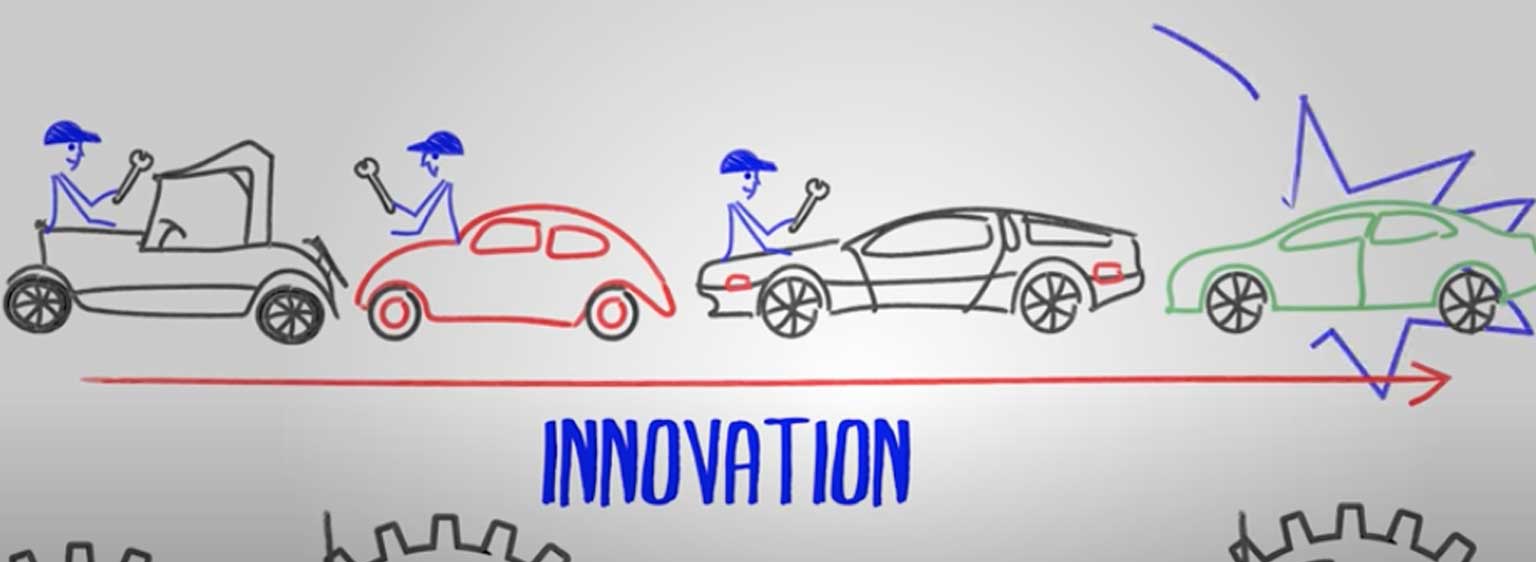In this brief video animation, LEI Senior Advisor John Shook illustrates how lean thinking and practice innovates work processes by explaining the differences in Ford’s approach in 1914 with that of Toyota in 2014. Find the transcript below.
So, what you see here are two photographs, one taken in 1914, the other in 2014. One is of Henry Ford’s first assembly line in Detroit, Michigan, taken in 1914, which is when he invented the assembly line. The other is 100 years later at a Toyota assembly line. Now what’s remarkable to me as I look at those is how amazingly alike they are. In a way, it’s almost the same. If you were to walk by, kind of a drive-by, they’re almost the same.
What Henry was doing a hundred years ago is what Toyota is doing now: you take a coil of steel, and you stamp it. And then you weld those stamped pieces together into the shape of a shell of a body. Then you paint it, and then you stuff it full of stuff. And to make one car takes somewhere between 10,000 and 30,000 parts, depending on how you count them. And it takes about one minute to make a car. And that was true a hundred years ago with Henry Ford before. And it’s true today with Toyota; pretty amazing.
And if it takes one minute to make a car, that means one person is doing about one minute’s worth of work every 60 seconds. And in 60 seconds, a person is doing maybe 10 or 15 different things. By different things, I mean they’re going to walk over and pick up a certain part or component and perhaps a certain tool, and they’re going to attach it to the car. And that also is exactly the same way today as it was a hundred years ago. But if you look more closely, what you can find is there have been a hundred years of innovation inside the work. So Henry Ford did an amazing innovation a hundred years ago to design, to come up with the assembly line. And then cars, the products themselves, have changed dramatically in that time. Also, inside the work, there’s been tremendous innovation, and that is what we have to thank lean thinking and practice for.
This illustration shows what’s going on inside an assembly line today, as developed by Toyota and now copied by all the other manufacturers in the industry — and many other industries as well.
Not all of us work on an assembly line, and we all have that image in mind of Charlie Chaplin working in, or being worked by, the assembly line; or maybe Lucy with the chocolates on the assembly line that she worked on. So, what’s happening on this assembly line? If the individual is working on a car and, as you can see, they have about 60 seconds to do the job. You can see where it says the beginning of the work, and you can see where it says the end, and that’s about 60 seconds. You can also see that the person is working on the back of this car. And you can tell that they’re having a problem. You can tell that by the furrowed brow, and that’s at about at the 40-second mark. So that’s interesting already. And that’s a big difference already between what’s happening on a Toyota or a lean assembly line today versus what Henry Ford gave us a hundred years ago. Henry said, “What I want of you workers is your hands, not your heads. And I want you to keep working, keep working; the assembly line never stops.” In this case, the worker sees that they have a problem, and they were able to actually detect the problem, and now they know what to do, which is reach up overhead and pull a cord. They don’t have to look for the cord. The cord is right there. And then the worker also knows what’s going to happen next, which is someone is going to come and help them
determine what to do about this problem that’s occurred, and they’re going to provide that help within the job cycle. That’s an amazing thing.
You’re going to have hundreds of workers on this assembly line. Each of them may be having a problem at any given moment. And now they’re able to signal whenever they have a problem; they’re able to make sure that the problem that’s occurred, perhaps it’s a defect, will not escape their zone. Never pass on a defect. So what I’ve done now is I’ve asked each worker to be an inspector. I’ve asked each worker not just to do the work I’ve given them as a mindless robot but to look for things gone wrong. So when I give that 10 or 15 things for the worker to do, their standardized work, I’m asking them not just to do it over and over and keep the line running. I’m asking them to find things going wrong and look for improvements. So this worker is now engaging their mind and finding things by exercising their human creativity, their talents to make improvements.
And I didn’t just passively ask the person to do that. I’m giving them the skills. I’m giving them a user-friendly job, to begin with, so they can do the job successfully most of the time. And they know how to spot a problem. They know how to spot a problem, which is anything that gets in the way of them successfully doing their work in 60 seconds. And they know exactly what to do once they’ve found a problem, which is to signal that a problem is there to contain and notify, and they know what’s going to happen next, which is someone going to come and help decide what to do. Is this a problem that we need to deal with right now? What is going on? Shall we stop the line? And, in fact, if they don’t solve the problem between that 40-second mark and the 60-second mark, the line will actually stop.
So what Toyota did was turn on its head the roles and responsibilities that Henry had put in place. Henry Ford said to the production workers, “You just build, you just guarantee the quantity, never let the production line stop; someone at the end who’s smarter than you and more well-paid than you are will look and fix anything that’s gone wrong, or they may just decide to ship it anyway.”
What lean thinking says is, “I want you, everyone doing production work, to own the quality, make sure that every single job you do is done perfectly. So you now own the quality that will go to the customer, which is following the process in addition to the final product. So in that way, I want to engage your hearts and minds in building perfect quality and making continuous improvements. So on the surface, 1914 to 2014 looks almost the same. Underneath it is endless continuous innovations to the work. And it is this innovation to the work that makes things better for everyone involved. It makes things better for the worker, makes things better for the company, and makes things better for the final customer. That’s what lean thinking and practice are all about, and that’s why we like to start with the work to make better work for the people who do it.
Learn More About Lean Innovation
Explore the meaning of “innovation” and lean thinking’s relationship to it in Innovation in the Work.
Improvement Kata/Coaching Kata
Develop Scientific Thinking, a Foundation of Lean Management in the 21st Century.





